
Build my resume
- Build a better resume in minutes
- Resume examples
- 2,000+ examples that work in 2024
- Resume templates
- Free templates for all levels
- Cover letters
- Cover letter generator
- It's like magic, we promise
- Cover letter examples
- Free downloads in Word & Docs

22 College Student Resumes That Landed Jobs in 2024
- College Student Resumes
- College Student Resumes by Role
- College Student Resumes for Academics
Writing Your College Student Resume
Companies sometimes require that entry-level candidates have experience, but how do you get experience when even entry-level jobs make it difficult to apply?
Getting that first job or internship can be the most challenging part of your career. Fortunately, as a college student, you’re in a great position to get that first break you need. Once you get your degree, you’ll have the experience employers are seeking, but until then, how can you build an effective resume or write a cover letter as a college student?
After reviewing countless resume samples , we’ve determined what types employers want to see from college students. Furthermore, we used that knowledge to create 22 college student resume examples to help inspire your resume in 2024 .
College Student Resume Example
or download as PDF
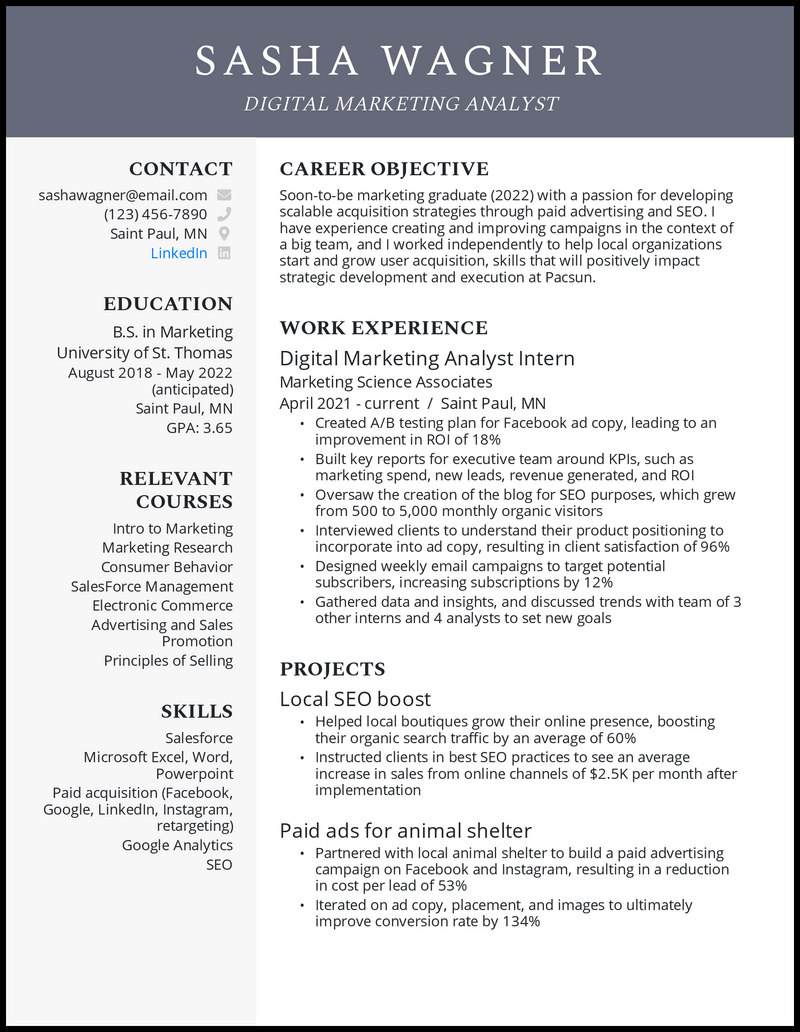
Why this resume works
- This lets employers know when you can work full-time. Whatever you do, be honest. Stretching the truth won’t get you any points with employers. It’s better to be upfront and willing to learn a skill rather than try to succeed by the skin of your teeth.
- The golden rule on your college student resume is to lead with your strengths. If you’ve got a relevant internship, add it. If you’ve done any related class projects, list them. No matter what you include, make sure to highlight transferable skills.
Undergraduate Student Resume

- To impress the recruiter, demonstrate the dedication you have had in your previous posts despite minimal experience.
University Student Resume

- In that case, your university student resume can capitalize on your analytical skills, which helped identify cost-saving opportunities and cut overall expenses by six percent.
College Student No Experience Resume

- Luckily, there are a host of resume templates you can use to format your experience well, so long as you adjust based on your qualifications.
- For example, you can add or remove sections based on the amount of work history you have (or don’t have).
- For example, being on the club basketball team may feel irrelevant to business analysis. But by focusing on how you’ve organized practices and led a local volunteer effort, your college student no experience resume can point to qualities that might appeal to a thoughtful employer.
Current College Student Resume
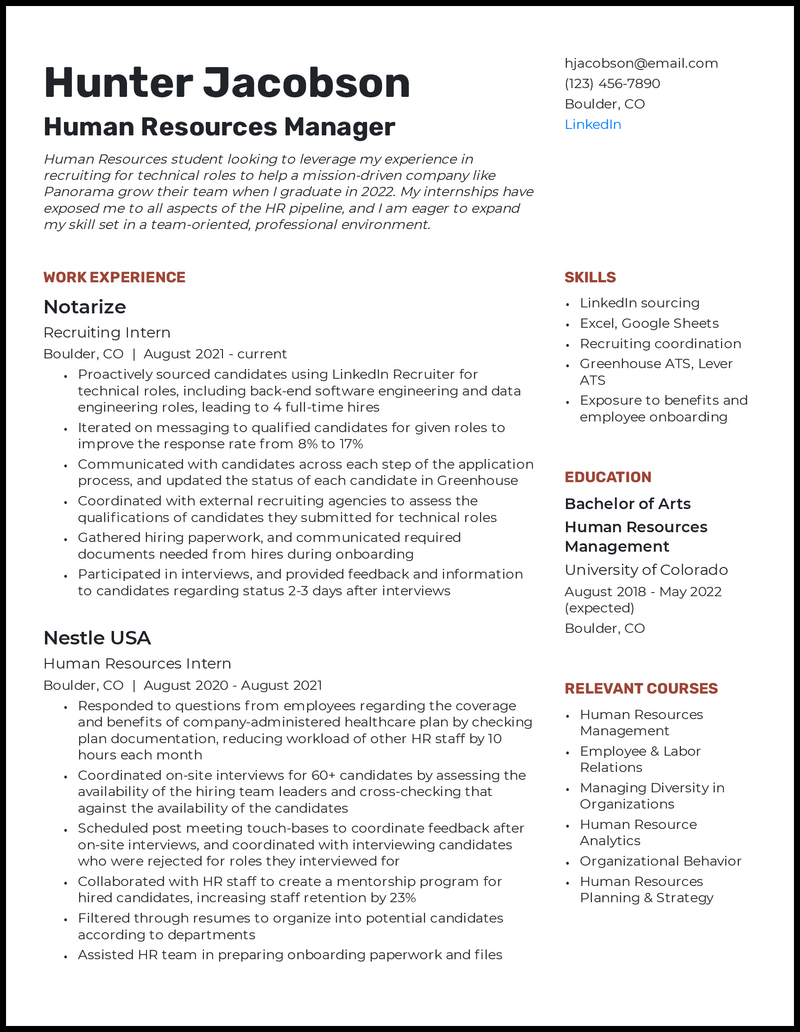
- A reverse-chronological format is still the most accepted, but if you want to highlight your skills, try using a functional format instead.
- Adding relevant metrics shows that you know what matters to your employer and you’ve positively impacted your previous workplace.
College Student for Internship Resume
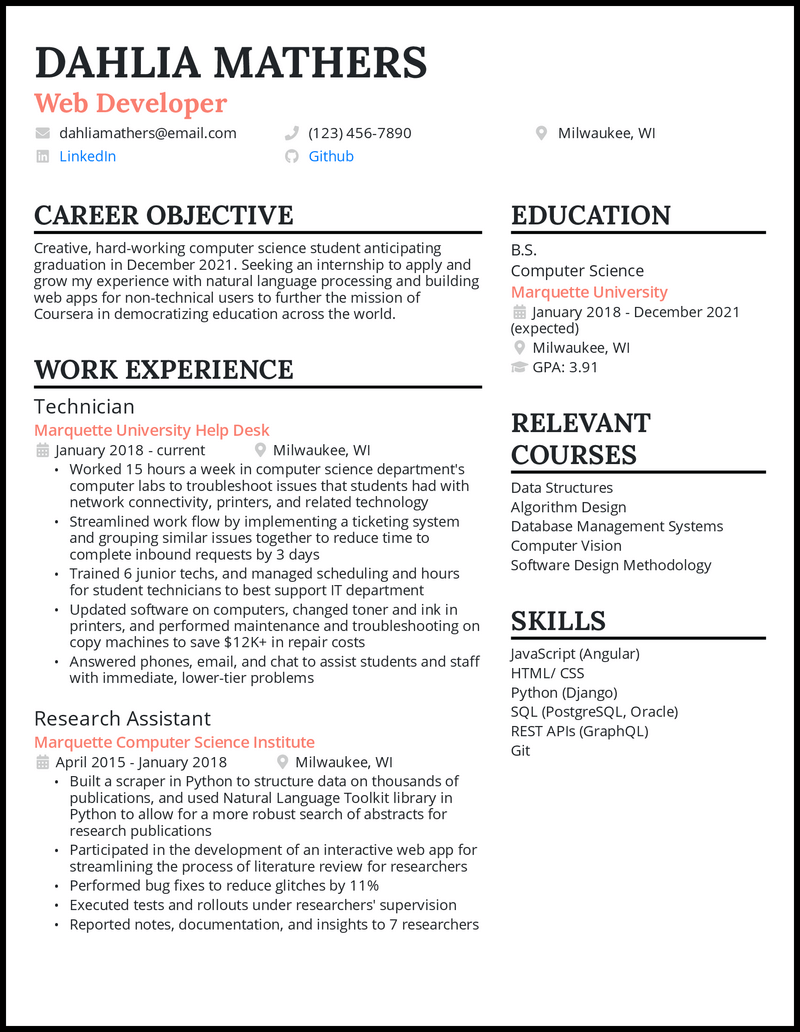
- That’s okay—you can weave in other things, like projects and part-time jobs. Of course, if you do have internship or job experience, put that at the top.
- It’s as easy as checking the job description . Then just list your relevant abilities according to what matches the keywords listed by the employer.
College Student Assistant Medical Laboratory Technician Resume Example
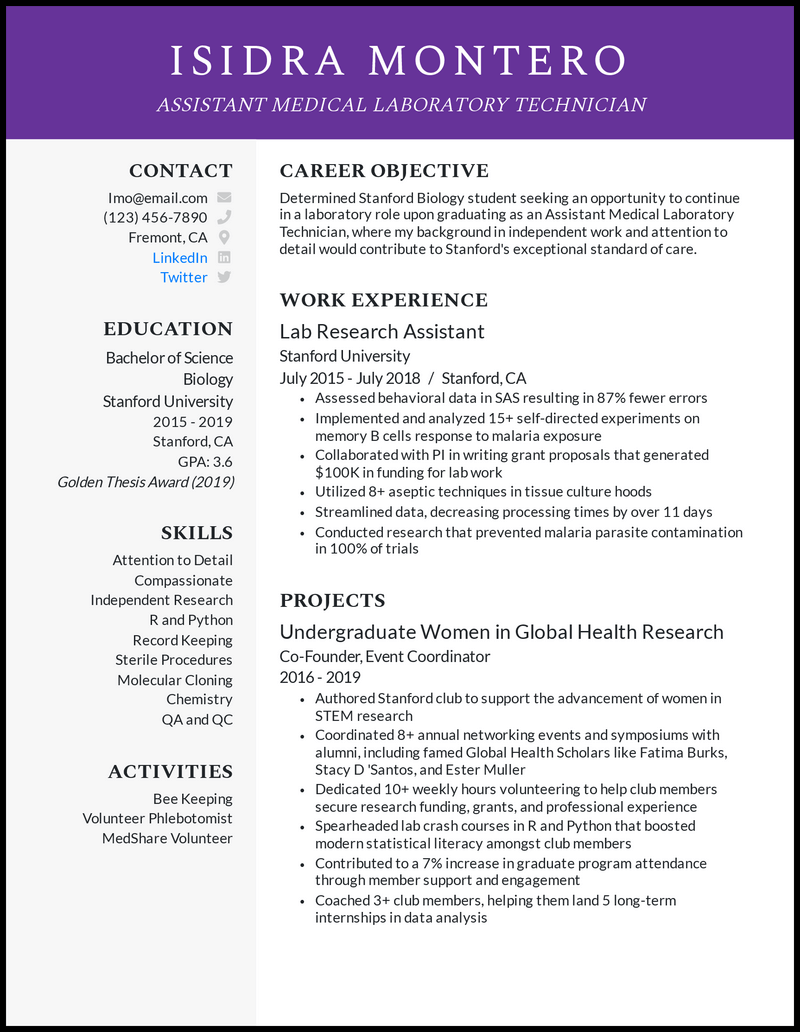
- Do you have a unique interest related to science? Are you involved in a sport? Do you volunteer? All of these hobbies are great additions to your resume.
- If you’ve just graduated, you can bulk up your education section.
- Feel free to add any college awards you won and your GPA (if it’s higher than 3.5).
College Student HR Executive Assistant Resume
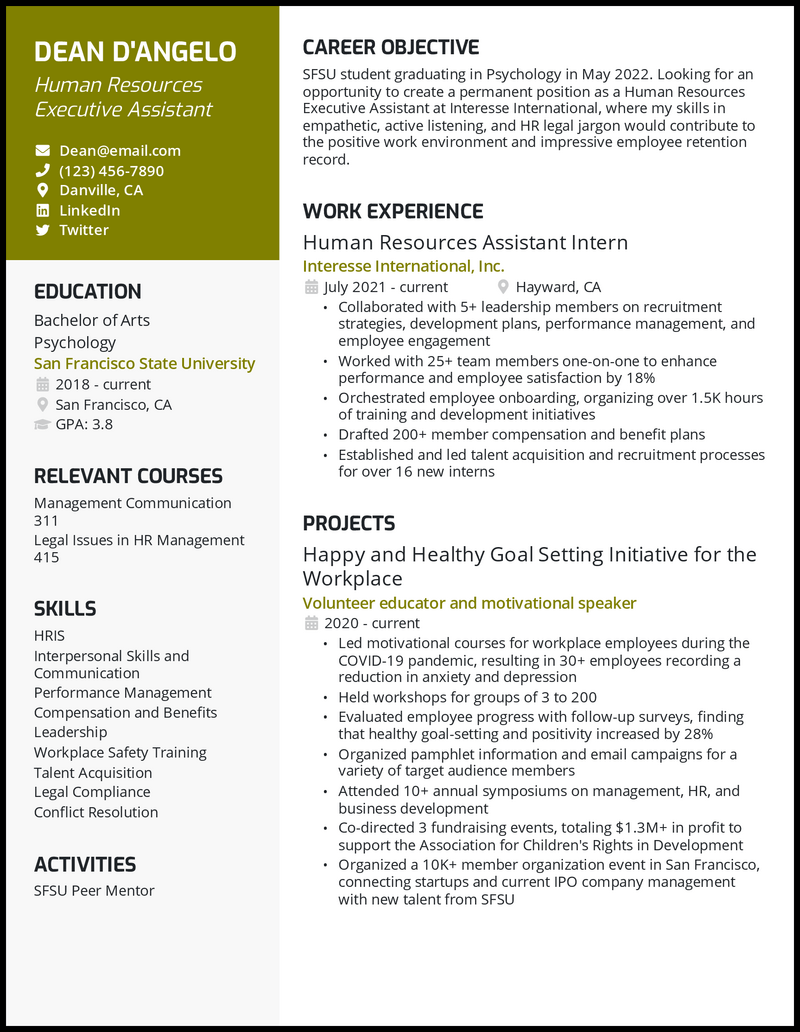
- As a rule of thumb, we recommend including one if you’re light on experience or are going through a substantial career change. Otherwise, leave it out in favor of work experience.
- Good skills to include on an HR executive assistant resume are “talent acquisition,” “conflict resolution,” “legal compliance,” and “compensation/benefits.”
- An even more effective way to breathe life into your skills is to weave them into your work history or project bullet points.
College Student Case Assistant Resume
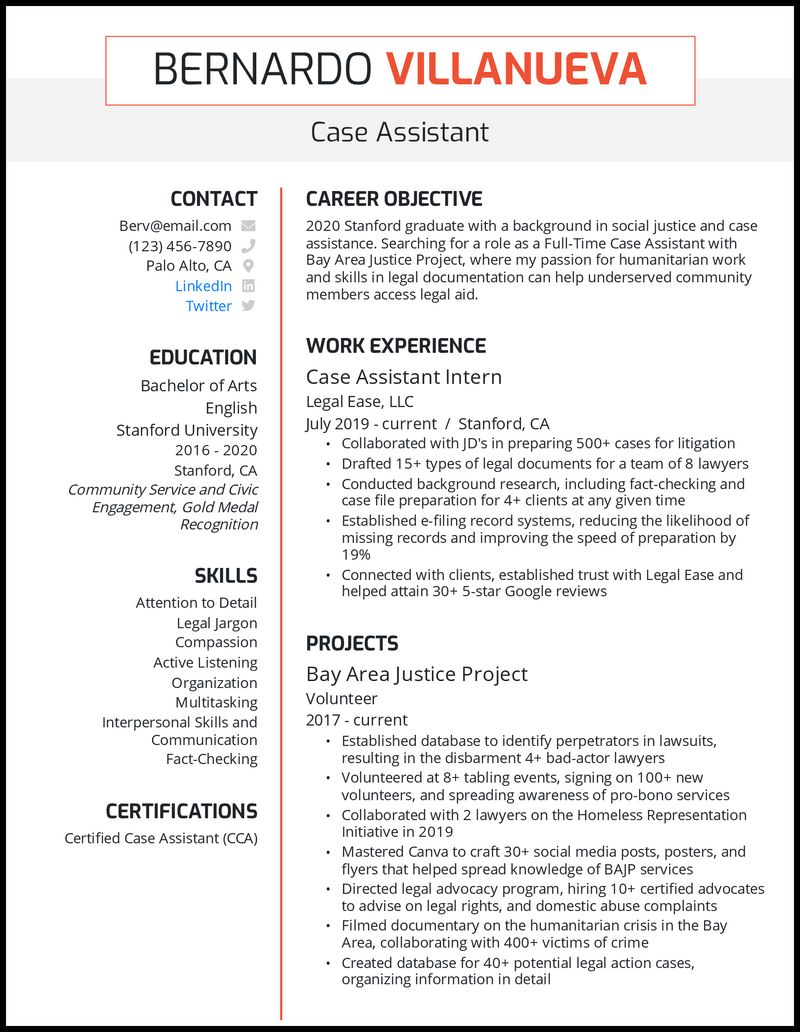
- Show off your personality using contrasting colors, classic fonts, and well-organized layouts. Our ready-to-build resume templates or handy Google Docs interactive resumes can help you keep your resume both tasteful and personable.
- If you don’t have certification, then now’s the best time to get it. Better late than never!
College Student Resident Assistant Resume

- Though an objective isn’t required, it can help employers see your skills and experience straight away.
- Just make sure to tailor it for every job you apply for by including the name of the employer, the position you’re seeking, and some matching keyword skills (that are true about you) gleaned from the job description .
- You also shouldn’t feel limited by your work experience. If you’ve done any relevant projects or have volunteered, include them! Employers love to see transferrable skills like collaboration, a good work ethic, and organization.
College Student Warehouse Worker Resume

- If you’re struggling to get going, consider using a resume outline to help you structure your experience—just don’t forget to fill out all the sections thoroughly!
- While it’s not impossible to land an excellent job without internships or experience, having some kind of work history, even in the form of projects, will allow you to be more picky and skim from the top of warehouse positions.
College Student Teacher Assistant Resume
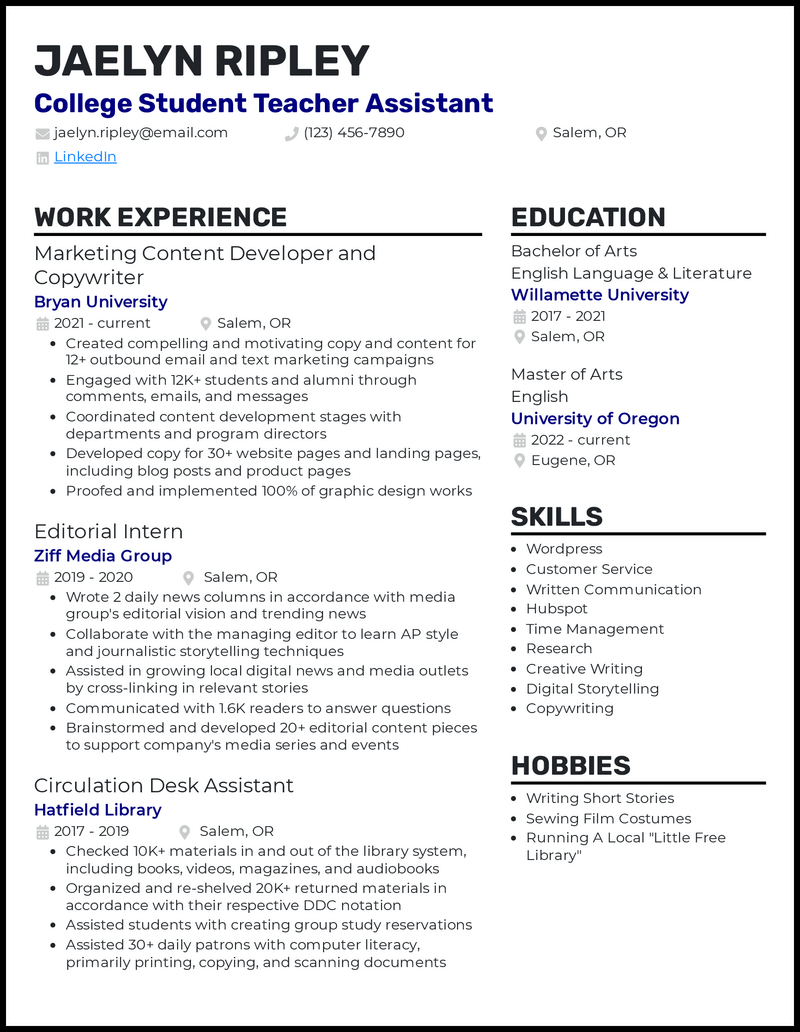
- Adjusting formatting details, like the layout and header colors, can make your resume pop and reveal a bit about yourself. (Red and pink are bold, daring colors, while blue and green are calming.)
- Adding a hobbies and interests section to your resume can also help catch the eye of employers, provided you list hobbies that are relevant to the desired job, such as creative pursuits, volunteering, or research.
- Even if you’ve never had experience as a teacher assistant, you can instill confidence by demonstrating the impact of your communication skills. Did you effectively resolve an issue using negotiation? Write something that added helpful clarity? Show how you used communication to affect others positively!
College Student Biology Lab Technician Resume
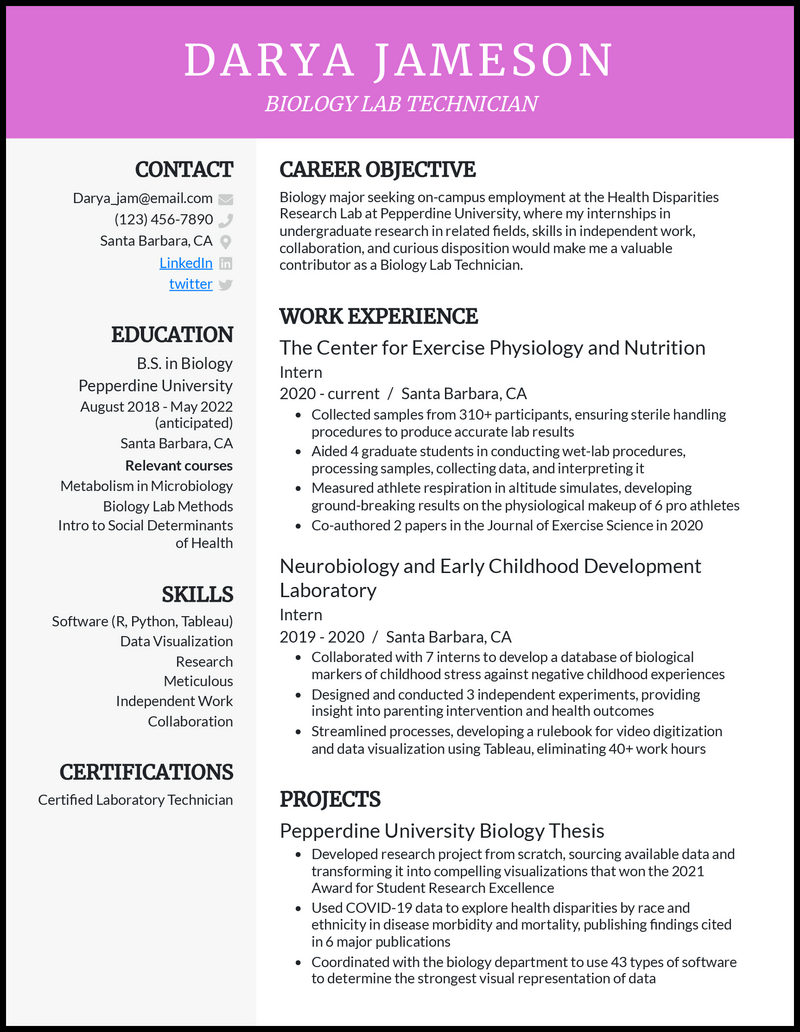
- Don’t get too carried away here; after all, it’s still a resume and not a flier for a Wednesday Night Disco. But, one to two colors can be appropriate for all but the most conservative working environments.
- Numbers can be frustrating to calculate and add to your resume, but trust us when we tell you that they make a world of difference. Hiring managers are consistently more willing to interview people with metrics on their resumes, as they convey job competence and confidence.
College Student English Tutor Resume
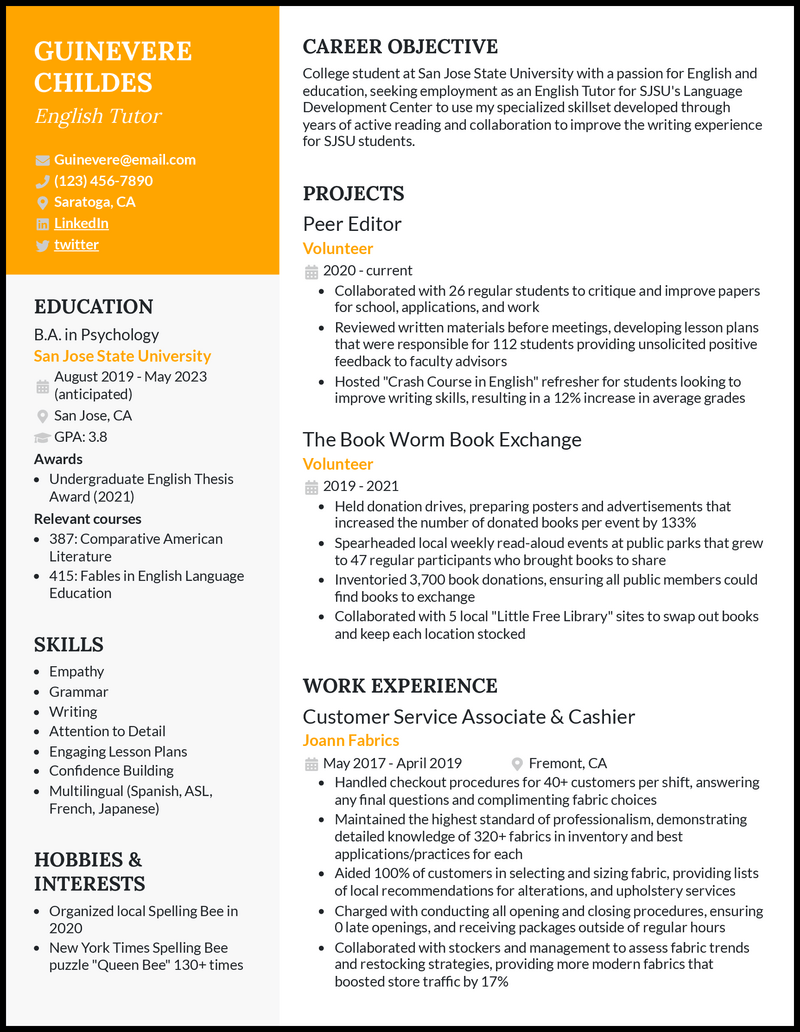
- Breaking up each work experience into bullet points can make your resume both easier to read (with fewer blocks of dense text) and easier to write.
- Instead of writing one big chunk of cohesive text, you can focus on pulling out as many highlights about your work history at each job as possible.
- A project can be anything. Seriously, your final group project from that writing seminar counts, or you could highlight a blog you’ve been working on in your free time.
- Hint: Projects also make great stories to discuss on your college student cover letter .
College Application Resume

- Suppose you’re applying for a Bachelor of Arts in education. Express your passion for teaching and eagerness to advance your knowledge of education theories and practices. Even better, emphasize your long-term ambition to shape future generations through innovative education methods.
College Admission Resume

- Take a leaf from how Brian narrates his stints as a restaurant server, project presenter, and volunteer. Well-described, such experiences paint a picture of a well-rounded character who can take on varied challenges of an engineering program, enhancing their appeal in the eyes of the college admissions committee.
College Freshman Resume

- Use past projects to advantage here even if they’re only a year long. Clearly state how you used skills such as Canva and Microsoft Teams to make specific impacts during this time. Another great addition to your college freshman resume is any work experience under your belt.
Harvard College Resume

- You see reputable (and free) spell checkers like Grammarly? They’re your backstage crew making sure that your Harvard college resume is polished—no typos, grammatical mistakes, or punctuation errors in sight. And getting a friend or family member to take a peek? It’s always a brilliant move.
College Level Resume

- It’s a piece of cake. Maybe you’ve been a superstar nanny or the quickest cashier around. Identify competencies from these gigs, whether communication, time management, or leadership, and then blend them into your work experience. Simply put, connect the dots in your college level resume, and you’re golden.
College Student Academic Highlights Resume

- Say you have some work experience, but it’s not relevant to the job. That’s okay—instead of trying in vain to match the job description , focus on transferable skills like customer service, organization, event planning, public speaking, and computer literacy.
- If you lack much work history, adding projects, coursework, or volunteer experience is the next best way to showcase your potential. You can also list your involvement in clubs, organizations, or peer mentorship.
- Write them like you’d write work experience by using active verbs and incorporating metrics (numbers).
First Year College Student Resume

- Your time contributing to a project is tangible evidence of your skills and experiences. Depending on what you include, it could showcase your communication and organizational skills or more technical abilities, like your proficiency with Microsoft Office.
Freshman College Student Resume

- Do you love gardening or nature photography? Awesome, it shows you’re inherently passionate about biology. Do you spend your time baking as well? It’s a sign that you know how to follow instructions and observe changes over time—skills that will come in handy as a lab assistant.
Related resume guides
- College Graduate
- Grad School
- Entry level

Before we dive into the difference between a resume objective vs. a resume summary , let’s get some definitions out of the way:
- Resume objective : A statement of your qualifications, interests, and skills that make you a good fit for the role to which you’re applying.
- Resume summary : A summary of your past experience detailing your high-level accomplishments and projects.
When you’re applying for a job or internship as a college student, you likely won’t have extensive work experience. So, we’d recommend including a resume objective instead of a resume summary.
The goal of your resume objective is to set the stage for your resume. It should highlight your skills applicable to the job at hand, and it should be specific for each job to which you’re applying.
Most resume objectives are boring and generic. By taking the time to craft a customized and effective resume objective, you give yourself an edge over other applicants and increase your chances of getting an interview.
Before we dive into the rules for creating a strong resume objective, let’s look at some examples.
Sample college student resume objectives
- “Recent college graduate with a degree in marketing looking for a full-time role where I can utilize my experience in social media and paid advertising to help an up-and-coming brand like Club Z! Inc. spread awareness and acquire more users.”
- “Diligent college student at the University of Pittsburgh who is equally committed to academic excellence (3.8 GPA) and service (student leader at the local food shelter) looking for an opportunity at Unidos as a part-time employee to utilize these talents to improve customer satisfaction.”
- “Recent graduate with a Masters of Business Administration (MBA) seeking an opportunity within an established management organization to utilize my organizational and quantitative abilities. Epic seems to have a culture of empowering employees to have ownership over their problems, and that culture fits my work style perfectly.”
You can see that all of these resume objectives specifically mention the company that the student is applying to. Tailoring is the golden rule of resume objectives.
Here are some other rules to make your objective the best it can be:
- Again, take the time to customize your resume objective for each company to which you’re applying .
- Don’t be afraid to inject your personality. Making an impression will help you stand out among the hundreds of other applicants.
- Keep it to two to three sentences.
- Mention any relevant skills or certifications you have for the role to which you’re applying.
College Student Resume Formats

One of the hardest parts of using a resume maker as a college student is the blank page. The “getting started” part is overwhelming—you’re unsure what your resume should look like, let alone what should be in it!
When it comes to formatting your resume, the best advice is to keep it simple . You need to convincingly make the case that you deserve an interview for the role to which you’re applying.
In short, your resume should likely contain the following sections:
- Header: This is your name and job title. Have your job title match the job title to which you’re applying.
- Resume objective: We talked about this above, a quick summary of your skills and what you’re seeking.
- Education: As a college student, this should include your anticipated graduation date, the field of study, and relevant classes.
- Skills: List six to ten technical skills relevant to your career.
- Work experience: If you have any relevant internships or part-time jobs, mention them here.
- Projects: Did you do any side projects that demonstrate your competency? Include them!
Not all of these sections need to be included in your resume. Your resume should focus on your strengths.
If you don’t have much relevant work experience, you can omit that section in favor of discussing your projects or classwork.
However, no matter what format you choose, there are a few writing guidelines you should adhere to throughout your resume.
Formatting guidelines for your resume
- Keep your resume to one page! Your resume should only extend to a second page when you have 10+ years of experience.
- Avoid any spelling or grammar errors by double-checking your text and having a friend review your resume. Don’t let typos be the reason why you don’t get an interview.
- Break up your work experience into small, consumable bullet points. Nothing is harder to read than a big wall of text.
- Use reverse-chronological order to keep your most recent experience/projects at the top.
- Don’t include fancy images or graphics. It’s highly likely a computer will read your resume before a human ever does, and images are hard for computers to scan.
- Don’t list more than ten skills on your resume. (We’ll expand on this below.)
Skills to pay the bills
When building your skills section, it can be tempting to list any and every skill you know. You’ll have to resist this temptation.
Before a human reviews your resume, an automated system called an Applicant Tracking System (ATS) will score your resume based on whether or not it includes the “right” keywords. These filters are largely screening for specific skills.
Doesn’t this mean that you should include as many skills as possible to beat the ATS? Unfortunately, you need to make your resume appealing to both the ATS and a human, and nothing is a bigger red flag to a hiring manager than a candidate with a laundry list of skills!
You’re much better off focusing on six to ten skills you’re an expert in than including more that you kind of know. Generally, if you wouldn’t be comfortable being interviewed on a given skill, don’t include it on your resume.
Work Experience and Projects

In any resume, no matter the career stage, your work experience and projects should take up at least 70 percent of the overall space. These will decide whether you get an interview or not.
Once you have a few years of experience, then the size of your projects section will decrease as the size of your work experience section expands.
If you have an internship relevant to the job you’re applying for, this should be listed in your “work experience” section. As a college student, your work experience can also contain any part-time jobs you had while in school, even if they don’t seem relevant to the position to which you’re applying.
It’s not easy to balance work and school, so having a part-time job demonstrates responsibility and drive.
When talking about your work experience, there are a few key tips you should follow:
- Mention the skills you demonstrated on the job.
- Quantify the impact of your work whenever possible.
- Talk specifically about your role; avoid being too general.
- Use action verbs like “owned” or “led” to highlight your leadership abilities.
Numbers truly speak louder than words, especially on your resume. By providing numerical context around your work, you show your ability to contribute meaningfully to your workplace.
Compare these two descriptions of an internship. Which do you think would be more compelling to a hiring manager?
WRONG – general work experience descriptions
Marketing Science Associates April 2020 – Current, New York NY Digital Marketing Intern
- Created testing plan for Facebook ad copy
- Built key reports for the executive team around KPIs
- Oversaw the creation of the blog for SEO purposes
- Worked closely with clients to understand their product positioning to incorporate into ad copy
RIGHT – specific, quantified descriptions
- Created A/B testing plan for Facebook ad copy, improving ROI by 15%
- Built key reports for the executive team around KPIs such as marketing spend, new leads, revenue generated, and ROI
- Oversaw the creation of the blog for SEO purposes which grew from 1,000 to 5,000 monthly organic visitors
- Worked closely with clients to understand their product positioning to incorporate into ad copy, leading to client satisfaction of 99%

Projects can be anything
If you don’t have much (or any) relevant work experience for your resume, don’t fret. You can still create a highly effective resume by showcasing your projects.
As a college student, you’ve likely done a lot of class projects that are relevant to the job or internship you’re looking to get. This is the perfect place to talk about those projects. You can even mention projects you completed outside of class. Talk about your goals, the methods/skills you used, and the project’s outcome.
The key is to include anything that will convince the hiring manager you have the drive, skills, and ability to translate your academic knowledge to the real world and contribute to the roles for which you’re applying.
Here are some potential projects you can work on for different majors:
Project ideas for college students
- Are you a business student? Detail a case study that you analyzed and presented in a class.
- If you’re a marketing student, you can write a short blog post about how you’d improve the paid marketing strategy for a company you admire.
- As a graphic designer, this is a great opportunity to talk about some of the projects in your portfolio.
- If you’re looking for a data analyst role, talk about how you analyzed stock data to determine areas of opportunity.
- As a human resources major, you’ve likely created processes for companies as part of a class, so talk about that.
- Software engineering students complete meaningful coding assignments all the time. Discuss one of those or talk about your side project.
- If you’re looking to break into product management, discuss a hackathon you were part of or create a case study for a feature your favorite product is missing.
Basically, the projects you include on your resume can be just about anything. They simply have to demonstrate you know what is required of the kind of role you’re applying to, and that you can meet those requirements.
Your Education Section

As a college student, it should go without saying that you need to include an education section on your resume.
Here’s what you need to include in your education section no matter what:
- The school you’re currently attending (or recently graduated from). You do not need to include your high school.
- Your graduation date (or expected graduation date). You can give just the month and year.
- The kind of degree you’re working toward (bachelor of arts, bachelor of science, master’s, etc.).
- Your field of study.
Once you include all that, there’s more flexibility. If you have a strong GPA (greater than 3.5), you should include it, too.
If you don’t have much experience yet, then you can add relevant courses or awards to your education section, provided they’re relevant to the job for which you’re applying.
For example, if you’re applying for a role as a data scientist, then it makes sense to include any math, economics, or programming classes you completed.
Here’s an example of an effective education section for a college student looking for a marketing role:

If you received any awards or honors during your time in college, list them here. These can include getting on the Dean’s List, any department-specific awards relevant to your major, or formal recognition for your work or volunteer efforts.
Resume Builder for College Students
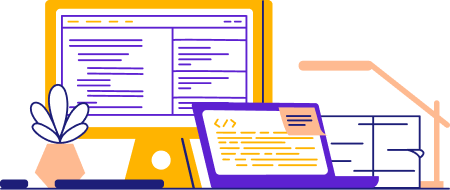
There you have it—we’ve discussed the building blocks to help you land a job or internship as a college student!
In summary, here are the keys to making an effective resume as a college student:
- Inject your personality into your resume objective and customize it for each company to which you apply.
- Your resume format should include a header, resume objective, skills section, education, and work/ project experience.
- Include any relevant internships or part-time jobs you’ve had during college and quantify the impact of your work.
- If you don’t have much working experience, include relevant projects you’ve completed either in the classroom or on your own time.
- Your education section is your chance to highlight classes you’ve completed that will convince the hiring manager you have the right tools for the job.
Finding a job or internship as a college student can be incredibly stressful. Building an AI resume is a huge first step, so pat yourself on the back. After you’re done with the writing, you can check your resume against our AI-powered tips to see how your resume matches up.
Just remember, it does get easier after you get some experience first. We can’t wait to see where you’ll go!

• We’ll show you how, step-by-step • Real, practical tips and tools • 100% free
How to Write a College Resume That’ll Get You Hired (Plus an Example!)

When you’re in college, a strong resume is one of the first things that helps you land an internship or part-time job. It represents you to employers when you can’t be in the room (yet!) and is essential to convincing them to call you for an interview based on your previous experiences and current skills. Whether you have a resume you used for college applications or are starting completely from scratch, putting effort into your resume now gives you a higher likelihood of success and sets a solid foundation, making it a breeze to update in the future as you—and it—evolve.
If you feel like you have nothing to put on your resume, don’t worry. After advising hundreds of students on these documents, I know you have more to offer than you think! I frequently meet first-year college students who believe they can’t include many of the things they did before college on a resume. You absolutely can—and you should—until those get outranked by all the other awesome things you’ll accumulate over the course of your college career. Even if you’re a freshly minted high school graduate, you have valuable skills and experiences employers want, and this guide can help you showcase them.
Read on to learn about what goes on your resume, how to format it, and what else you can do to ensure it makes you shine—and to see our college resume example.
What Goes on a College Resume
In setting up your resume, you should use a few core sections to help you easily lay out all the information a recruiter is looking for when they make quick decisions about whether or not to interview you. (And yes, recruiters do skim, reportedly spending an average of 7.4 seconds making their first pass on a resume, so you want to make a good impression fast).
Contact Info
It’s traditional to start with your basic contact information at the top of your document including your name, email, phone, and the city and state where you live. Use your full name (and maybe bump up the font a point or two because you’re a big deal!), and if you have a nickname you prefer, you can include it in parentheses.
Use your college email as it’s typically professional and establishes your educational brand. Now is also a good time to check that your phone’s voicemail greeting is up-to-date. In case a recruiter calls while you’re busy—or you don’t recognize the number and swipe it to voicemail—this greeting could be their first impression of you. Even recording something as simple as, “ Hello, you’ve reached Christine. Please leave a message and I will return your call as soon as possible, ” can help them feel confident they reached the right person and that you’re able to present yourself professionally.
Your physical location can be based either on your school’s address or your permanent home address. If you’re targeting opportunities in one location or the other, include the most local address so they know you’re familiar with the area (and likely won’t have a problem finding housing).
Pro tip: Save space by listing your email, phone, and location all on one line. If you have a LinkedIn profile , you can add that in your contact information section as well. The result might look like this:
Karla Perez Stillwater, MN ∙ (000) 765-4321 ∙ [email protected] ∙ www.linkedin.com/krperez
For college students, education should be right below the contact information on your resume. This immediately orients your reader to the fact that you’re a current student and conveys important information, like what you’re studying. What you include in your education section can also demonstrate that you’re a good match for the opportunity you’re targeting, increasing your chances of a recruiter call.
The basics you should always include are:
- Your school’s name
- Your expected graduation date
- The type of degree you’re pursuing: For example, you might write “Bachelor of Arts” or “Associate’s Degree.”
- Any majors, minors, or concentrations: If you’re applying to opportunities in these areas, this will help an employer see you already have some knowledge and a motivation for working with them.
Depending on your personal strengths and what jobs you’re applying for, you might also want to include:
- Your GPA: But only if it’s strong. (It’s usually good to include 3.5 and above.) If you stumbled through some of the general requirements you had to take but nailed all the courses in your major, consider adding two GPAs—your cumulative GPA and your major GPA—to show you have stronger grades in your chosen discipline.
- Standardized test scores: If you’re applying to opportunities in quantitative fields, like finance or consulting, you might consider listing standardized test scores like the SAT or ACT.
- Relevant coursework: Selecting and highlighting three to five classes that match closely with the specific opportunity you’re applying to is a really fast way to tailor your resume and make you a more attractive match. For example, if you’re targeting an internship in computer science, you can list your “Introduction to Python” and “Introduction to Algorithms” classes.
- Other colleges or universities you’ve attended: If you’re a transfer student or you studied abroad at another university, adding these schools can signal that you have other strengths, such as cultural awareness or language skills, or give you a chance to highlight key classes you took elsewhere.
- Your high school: If you’re shooting for an opportunity local to your high school or went somewhere well-known, then you may want to keep that as your last entry for educational experience. Otherwise, high school is the first entry to cut when you’re short on space. It has gotten you to where you need to be, but the focus should now be on the higher-level degree you’re working on and you should dedicate as much space as you need to boast about all of your amazing college accomplishments!
Here is an example of what a completed “Education” section might look like:
Candidate for Bachelor of Arts degree , St. Olaf College , Northfield, MN Double Major: Political Science and Economics ∙ Expected Graduation: May 2023 ∙ GPA: 3.7 Relevant Coursework: Introduction to Political Theory, Politics and Human Rights, Global Interdependence
The experience section is where the real substance of your resume lives. This is the chance to show a snapshot of the jobs and internships you’ve had (if any), the work you did, the skills you used, and your accomplishments. Let’s talk about what experience you can include, how to pull out skills and demonstrate your value, and what it should look like on the page.
Experience can cover a lot of things. It can be full-time jobs, part-time jobs, internships, or research. Unpaid work—like volunteer and community roles—counts too! Don’t discount the value these other kinds of experiences can add to your resume just because you didn’t earn money. You can leverage all of your experiences on a resume by pulling out transferable skills , or broader talents you’ve developed that will be beneficial even if you aren’t applying to the same type of role.
Take a significant class project, for example. That can be built out as experience as long as you’re clear it was for a class. If you worked on a group project, you probably collaborated on a team, organized, worked under deadlines, completed some independent tasks, presented your work to others, and had some kind of outcome. Even if you were doing something that might not seem widely applicable, like designing a rocket, many of those skills can transfer over to another role. Say you had to do cost comparisons for the materials you selected for your rocket, those same analysis skills could be useful to a business role or for a part-time job where you have to order supplies for a restaurant.
You can also create targeted headers for your Experience section(s) if there are themes that correlate with the internship or part-time job you want. Specific headers—such as “Research Experience,” “Marketing Experience,” or “Software Engineering Experience”—can immediately help your reader see that you’re aligned with the needs they have for their open role.
If you don’t have something that specific, it’s OK. You can still shift your experiences into categories like “Relevant Experience” and “Additional Experience.” For example, if you’re applying to research roles, you’d want to put any research related work under “Relevant Experience,” and your cashier job and website building side hustle would go under “Additional Experience.” These two headers are great for allowing you to bump the best of your experiences up toward the top of your resume.
Once you decide which headers to use, make sure each entry includes basic information—the title of your role, the organization’s name, the location, and the dates you worked there—along with bullet points describing what you accomplished. For example:
Intern , Minnesota State Senate , St. Paul, MN June 2019–August 2019
- Researched prior legislation and current bills, summarized content, and identified alternate actions
- Coordinated the schedule for Senator Harriet Maxwell and kept accurate minutes for all meetings
- Drafted memos for important interoffice updates outside of normal meeting schedule
A skills section is a great way to make your most valuable knowledge and expertise stand out—and be easily spotted by a recruiter. Which skills belong in your own skill section depend on the jobs you’re applying for, so be sure to read the job description carefully to figure out what skills are most relevant for each particular role.
Skills that might appear in this section include (but are definitely not limited to): technical skills; software or other tools you know well; languages you can speak, read, or write; other job-specific skills like using a POS system or cash register; and, for some jobs, even your ability to drive different vehicles.
From this range, you can see why it’s important to change things up based on what job you’re applying to! Some skills—for example, being fluent or conversational in a second language—might be relatively permanent fixtures on a college resume. If you’re looking for a part-time job waiting tables, you might add the fact that you can bartend, whereas you might list your mastery in JavaScript instead when going after that software engineering internship you have your eye on.
Once you’ve decided which skills are most important for this role, you can simply list them on your resume. If you have a few different types of skills, you can separate them into categories. For instance:
Languages: Spanish (Fluent); Russian (Basic) Software: JavaScript, Python, CSS
Note that just listing your skills in a separate section isn’t always enough. You also want to make sure to describe how you’ve used key technical and job skills elsewhere on your resume (usually in the bullet points of your experience section).
Other Optional Sections
There are some other sections you can consider adding depending on your experiences and what your target employer might be looking for. For example, a consumer product firm might be looking for examples of design work. In that case you could add a section called “Design Projects,” which might include significant assignments from some of your academic classes or independent projects that you’ve developed in your spare time. Don’t be afraid to include links to your work if you’re submitting your resume online! (Just avoid hyperlinking out from important words, as this could trip up the online systems that scan most resumes.)
Another popular section is “Leadership Experience” where roles like being the vice president for one of your student organizations or being a co-captain for your athletic team would be a good fit. Employers love to see leadership themes on resumes, as it demonstrates the transferable soft skills they’re looking for like communication, collaboration, and initiative.
An “Activities” section can also demonstrate skills. If you dedicate time to learning more about consulting cases with your consulting club, you likely increased your analytical skills in a team setting, which is valuable for many business roles. If you’re an athlete, you can showcase your ability to manage your time, create or be part of a cohesive team, or organize and motivate teammates during practices. These skills gained as an athlete can be ideal if you’re applying for a heavily collaborative role. Additionally, if the activities that you’re involved in are directly applicable to the job, these are powerful to include as it demonstrates interest and dedication. So if you’re majoring in healthcare administration, adding that you’re a member of the Healthcare Society on your campus can be a major plus for an employer.
Any optional sections like these will usually need to be set up similar to your experience entries. Include the organization (or class), your role, the location, the dates you participated, and your key achievements. Here is an example of an entry you might put under a “Leadership” heading:
Head Delegate , Model United Nations , Northfield, MN September 2019–April 2020
- Researched global topics such as human rights and sustainable energy and developed persuasive positions
- Represented Chile as a delegate in an education simulation at a conference with 2,000+ participants; negotiated with others and collaborated on common goals to deliver resolutions on political issues
- Liaised between the delegation and the Secretariat, serving as a first point of contact and resolving issues
6 Tips for Writing a Successful College Resume
From formatting to crafting strong descriptions, attention to detail can pay off when tackling your resume. Here are six tips to help you develop a great resume:
1. Choose the Right Resume Format for You
Your parents or other family members might share their resume and have you copy it because it has worked for them. But they’re at a different place in their career and their format may not be the best one for you.
There are three main types of resume formats for laying out your experiences, skills, and education—the functional resume , the combination/hybrid resume , and the chronological resume . The chronological format is almost always the best fit for college students.
With a chronological resume, you’ll list your experiences within each category/section in reverse chronological order (most recent to least recent, based on end date). Since this is the most traditional and common resume format, recruiters are familiar with it and can quickly see what you have to offer.
2. Be Clear and Consistent
In terms of resume formatting, there are a lot of small choices to make about things like font, style, and spacing. Whatever you decide, make sure it is easily readable, consistent, and not overly fancy. You could have the greatest content in the world, but if it’s too difficult or annoying to read, a recruiter is going to move on.
In order to make a document easy to scan, use clear headers for your sections. Maybe they’re bold and in all caps, or maybe they’re a couple font sizes larger, but they should be the same throughout your resume. The rest of your content should be consistent as well. For example, all your organization or previous employer names might be in italics, your dates all right aligned, your locations in plain text, and the titles of your roles in bold. Keeping things uniform helps the recruiter easily absorb all the relevant information you want them to have.
3. Make Sure It Can Pass Through an Application Tracking System (ATS)
Formatting is also important because your resume will likely pass through something called an applicant tracking system (ATS), a type of software that helps recruiters organize incoming candidate applications. Recruiters can apply filters or search for keywords, and the ATS will show candidates matching the desired criteria, making it easier to identify good candidates in large applicant pools.
In order for your resume to pass this first round and make it to the human who has the power to get you to an interview, the ATS needs to see you’re a good match. But there are formatting choices that can confuse an ATS—for example, some won’t read the content inside tables, text boxes, or graphics. And if the ATS can’t read your materials, your resume might be filtered out. (Read more about formatting your resume for an ATS here .)
This all means that using one of the fancy resume templates you see online isn’t necessarily the best move . Most basic formatting can be achieved with bolding, italics, and spacing, and you will still end up with a good-looking resume—meaning that starting with a blank document can actually be a better bet. (If you still want to use a template, we’ve curated 41 free ATS-friendly templates here .)
4. Create Impactful Descriptions
Give the descriptions you use for your experiences some TLC, as this is what recruiters will focus on once you’ve caught their attention. I often discover students undersell—or simply forget—all the things they’ve done that might be interesting and of value to an employer (including those transferable skills).
Here’s an exercise that can help. Reflect on an experience (such as an internship you had or volunteer work you completed) and quickly jot down what you did. You don’t need to have much structure for this—try it as a brainstorm. Think about answering some of these questions:
- What was your role?
- What were the goals for that position or experience?
- What tasks did you specifically do?
- What projects did you work on?
- Were there any side projects or tasks you completed?
- Who did you work with?
- What did you contribute?
- What did you accomplish? (Or what did/do you intend to accomplish? This can be a useful way to think about things especially when considering research or longer term projects that are still in progress!)
- Can it be quantified? Numbers can paint a clear and impressive picture of your accomplishments to someone reading your resume. You might write that you fundraised as part of the Student Government Association, and that will generally get your point across, but if you can say you increased SGA fundraising by 30% and were able to create two new social events attended by 100+ students each, that will make more of an impact. Look for ways to quantify your accomplishments wherever possible.
Once you have a good brainstorm, take the information you gathered and try crafting several statements using this formula:
Action Verb + Subject + Outcome/Purpose/Result (i.e. Accomplishment)
So you might say:
Organized a fundraiser event for 70 participants resulting in $1,000 in donations to a local hospital
Your descriptions are most valuable when leading with an action verb that reflects specific skills. For example, swap “Worked on” for “Collaborated on” and “Responsible for” with “Oversaw.” Other verbs I often recommend students use include:
- Communicated
- Facilitated
5. Tailor Your Resume for Each Opportunity
Always tailor your resume to each specific job you apply to. Making it easy for the recruiter to connect your skills to what they are looking for can increase your chances of success. The job description is your blueprint and key to doing this. A couple of these exercises could help you identify what you’ll want to highlight.
- Activity 1: Take the job description and go through and underline everything you’ve had some experience in. This might be specific tasks, software/programs/tools, or qualities. Write a quick note in the margin to highlight when you’ve done that. Underline things where you have transferable skills too. For example, if you’ve used a software that is similar to a software they’re looking for, underline it. A recruiter should be able to see on your resume that you used similar skills and would be a quick study.
- Activity 2: If you aren’t sure which skills to emphasize, take the entire job description and pop it into a simple online word cloud generator, like TagCrowd . It automatically shows you the words most used in the description, which are likely of highest importance to the company or role. If you have those skills, make sure you mention them in your descriptions and mirror the language as exactly as possible (our friend the ATS will be looking for precise keywords!).
These activities can help you identify the right action verbs, keywords, and tools—like software—to weave into your descriptions. They can also help you decide what past experiences to include or which of your college courses are relevant to this role and which direct and transferable skills to highlight to make your resume a stronger fit for your target job.
6. Keep a Few Other Tried-and-True Tips in Mind
Here are a few other parting tips to keep in mind as you build your document:
- Avoid writing in first person (“I,” “we,” “our,” and “my” statements).
- Bullet points will make your document more readable—usually two to three per entry works well. But it doesn’t have to be even: Give more description space to the most relevant entries.
- Attention to detail matters. Proofread—not just for typos, but to make sure formatting is consistent (like date dashes). Employers will use your resume to make assumptions about how detail-oriented you are.
- Review any headers you put in all caps. Some spell checkers are programmed to assume that they’re acronyms and skip them.
- Ditch jargon and acronyms wherever possible. Don’t assume the reader always knows what you’re talking about. Sometimes the first person reading your document is a general recruiter and not familiar with the technical side of a role.
- Be aware of tenses. If you’ve completed an experience, those descriptions will be in past tense, and current roles can be described in present tense. (If you’re still actively involved in a role you can list the role through “Present,” and if more than one entry has the same end date, make a strategic decision to put the most relevant experience first.)
- Acceptable margins are usually between one and 0.7 inches.
- Pick a readable font, like Arial, Calibri, or Times New Roman, and try not to go below font size 11.
- As a college student, stick to a one-page resume. However, you should consider keeping a longer version (called a master resume) for your own personal use. That’s where you keep a full record of your experiences to make it easier to pull out the relevant ones each time you tailor your resume for a specific job.
What Does a College Resume Look Like?
A college resume should showcase your education, experiences, and skills (direct and transferable!) in a clear way, while keeping in mind what is most relevant to your target employer. The resume below shows a student highlighting their relevant education and experiences specifically for internship opportunities in government and politics.
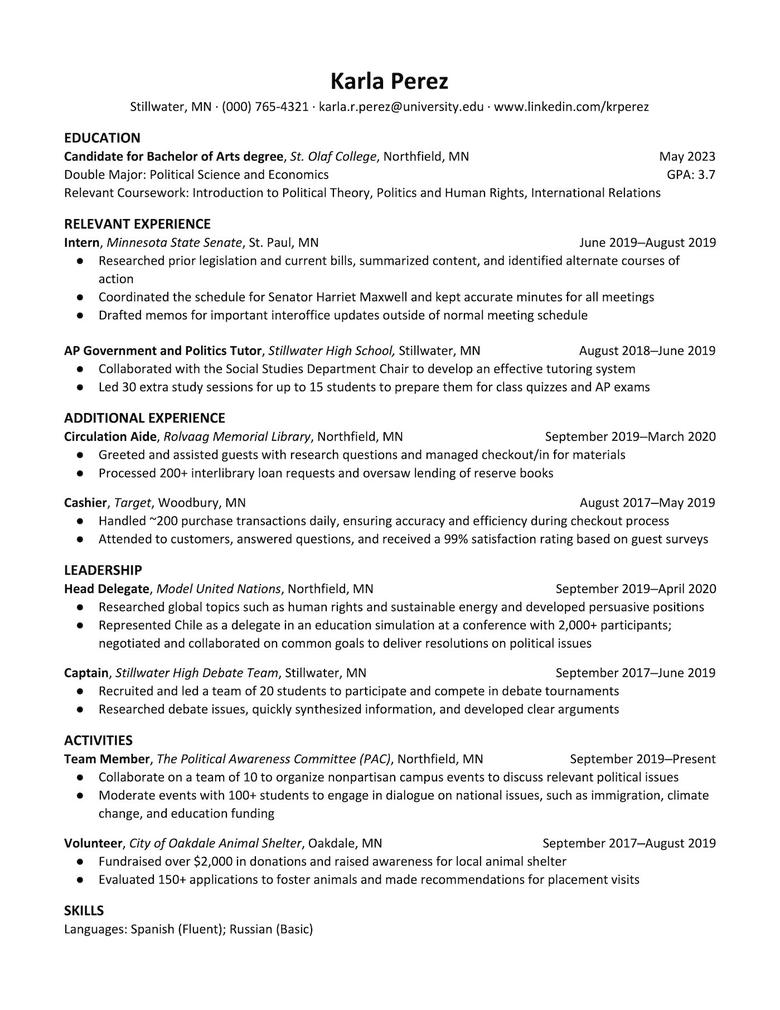
Download sample college resume
There are many ways to write and format a resume. Ultimately, you want one that best represents you and your accomplishments to recruiters for the job at hand. Try out some of these tips, and I hope they help you succeed in catching that recruiter’s eye!
College Application Resume for 2024 [With Examples, Tips & Template]

They say college is the most exciting time in a student’s life and we couldn’t agree more!
The only thing standing between you and your dream university, though, is a college application resume.
You open the resume document, get ready to start writing…
And nothing comes out! After all, how can you even make a resume when you haven’t worked a day in your life?
Worry not - you don’t need any work experience to write a compelling college application resume. In this article, we’re going to teach you just how you can do that!
What Should a Resume for College Application Contain?
- 5+ College Application Resume Formatting Tips
- How to Write a Resume for College Applications?
- 3+ College Application Resume Tips
College Application Resume Template
So let’s dive in!
Before we get into the knits and grits of writing a resume for college application, let’s first do a quick review of what your resume should contain:
- Contact information , including your full name, address, phone number, and professional email.
- A resume objective , where you state the goal of your college application resume.
- Education section , where you list the history of your grades and exam scores.
- Relevant activities , including any work experience you might have.
- Skills relevant to a resume for a college application, e.g. soft skills such as active listening, interpersonal skills, communication skills, or hard skills such as public speaking, MS Office, or computer skills.
- Additional sections , such as awards and honors.
6 College Application Resume Formatting Tips
Before we dive into the nits and grits of CV making, let’s talk about formatting. Here are our top tips on how to format your college application resume:
- Choose the functional/skills-based resume format. This format is perfect for those who lack work experience , as it focuses more on your skill-set. If you DO have some work experience, though, then you can opt for the chronological format.
- Keep your college application resume one page long . As a rule of thumb, this is the optimal length for a resume—professionals with 10 years worth of work experience stick to the 1-page limit, so there’s no excuse for someone with little to no work experience to go overboard.
- Add plenty of white space , especially around your resume’s margins. It will make your resume look less cluttered and more reader-friendly.
- Include clear section headings and use the same heading for each section.
- Use an easy-to-read font. Some resume fonts (such as Ubuntu or Overpass) are resume friendly—professional-looking, easy-to-read, and yet modern. Others, like Comic Sans, are just one big NO.
- Save your college resume as a PDF. You might be used to Microsoft Word, or even think it’s the safest alternative, but MS Word has a good choice of messing up your resume format if opened in different computers or operating systems. PDF files, on the other hand, remain the same no matter what computer opens them.
How to Write a Resume for College Applications? (With Examples)
Once you’ve got the formatting done right, it’s time to get to writing your college application resume.
In this section, we’ll walk you through that process, starting with:
#1. Order Your Contact Information the Right Way
As we already mentioned, your college application resume should start with your contact information.
These are your contact information section must-haves :
- Full name and address
- Functional phone number where you can be reached.
- Professional email address, preferably consisting of your first and last name.
And here’s what this looks like in practice:
Sharon White
123 Main Street
New York, NY
Phone Number: 553-123-1234
Email: [email protected]
#2. Write an Attention-Grabbing College Resume Objective
A resume objective is a 2-3 sentence long paragraph that should communicate your motivation for getting into college or for studying a specific major.
As such, a well-crafted resume objective can instantly attract admission officers to read the rest of your college application resume.
There is, however, a right and wrong way to write a resume objective.
A convincing resume objective is:
- Tailored to the university/major you’re applying to, instead of looking like a one-fits-all kind of statement that you can use to apply to several colleges.
- Highlights the achievements that give you an edge over the competition.
The following example does that right:
Aspiring journalist with a knack for creative writing looking to deepen their knowledge through NYU’s renowned Journalism track. Founder of my high school’s first online newspaper, the ‘Daily Prophet,’ which now has over 2,000 subscribers. Hardworking, with a grade A average in social sciences and commitment to improving.
Now compare it to the following resume objective, which although articulated looks like a one-fits-all kind of statement that you can just insert into several college applications.
Very committed high-schooler with a calling for social sciences. With an SAT score of 1400, a passion for psychology, and experience as a peer counselor, I am confident that my hard work and motivation will shine through as a college student.
See, the resume objective is your chance to show exactly why you want to attend that college, right from the start.
So, even if you don’t have many achievements to highlight, make sure to personalize your statement by expressing a genuine interest in your application.

#3. Put Weight on Your Education
Taking into consideration that, as a student, you most likely lack significant work experience, your education is the first thing admission officers will look at.
As such, you should give your education its due importance in your college application resume.
For starters, make sure to include this must-have information:
- Your high school’s name and location
- The date of your graduation
In addition, though, combine that with some relevant achievements that can make your education pop out.
Let’s take a look at two examples. The second student has simply listed out the essential education information, whereas the first has taken their education section to the next level.
Dunnellon High School FL
2017 - 2021
- 3rd place at the International Mathematical Olympiad
- Vice-President of the Science Club
- SAT Scores: 1350 (650 Verbal, 700 Math)
- SAT Scores: 1400
#4. Showcase Relevant Activities
Extracurricular activities have a great number of benefits when it comes to your college application resume. Most importantly, they:
- Demonstrate you who are outside of the classroom
- Provide an opportunity to showcase your skills
Any activity and/or interest related to the college you’re applying to has a place on your college application resume, but you don’t have to necessarily stop there.
Any kind of interest, field, or activity where you’re good at can be of benefit to your application.
That’s because it can prove that your interests are not focused solely on your favorite subject or desired career path and that you are engaged and well-rounded .
So, don’t just list your college resume activities dryly (e.g. “reading” or “swimming”). Instead, be specific and creative about your interests, and rest assured that you will get extra points for diversity and commitment.
Don’t believe us? Compare for yourself how the activities sections of two different students look like: the first has put minimal effort into it, whereas the second has put his A-game into writing it.
- Passionate about science
- Co-founder of the Astrophysics Club
Activities
- Two-times winner of my high school’s Science Fair
- Co-founder of the Astrophysics Club, finalists of the MIT-founded THINK challenge
- Swimmer from an early age and member of my high school’s swim team during junior and senior year
- Traveling; I have so far visited 10 countries and 15 states in the USA.
- Photography, with a focus on architectural photography.
#5. Highlight Your Work Experience
Now, if you’ve spent your summer holidays working any type of job for teens , that means that you also have some work experience under your belt.
Although work experience is not necessary when you’re applying for college (meaning that you won’t get left out of college if you don’t have any), it does help to include it if you have it.
Here’s how to list work experience in your college application resume:
- Start with the company name (e.g. if you worked at Starbucks), your job title, and the period you worked there.
- Put your job title first if you worked, say, as a high-school tutor or camp counselor.
- Include 1-2 of your main responsibilities in bullets. If you have achievements to show for, however, make sure to put them first.
Let’s see how that works in a practical example.
Starbucks Coffee
- Awarded employee of the month for 3 months straight
- Fielding customer complaints and questions
- Maintaining good customer service and speedy delivery
Even if the above position isn’t related to the student’s desired field of study, the work experience still highlights some of their skills such as commitment, time management, effective communication, and motivation.
#6. Include Your Skills
Skills—we all got them, but not everyone knows how to demonstrate them effectively in a college application resume.
There are two things to consider when you include skills in your college resume:
- Know the kind of skills that are relevant to your major/field.
- Prove your skills, instead of just listing them
Let’s show you how that works through practical examples:
- Time management
- Critical thinking
Are these great skills for a college applicant? Sure!
But anyone can claim to have those skills (and frankly, most people do).
Rather than just listing these skills, you want to also back them up with achievements and experiences like so:
- Attention to deadline: managed to update the high school’s online newspaper daily
- Leadership: successfully led a team of 6 reporters.
- Creativity: won the 2021 Young Writers competition
- Self-motivation: founded the high school’s first online newspaper
Now, this is a skills section on a college application resume that proves you deserve a spot in your favorite university.
College application resume skills
Wondering which skills to include in your college application resume? Here’s a list to draw some inspiration:
Soft Skills
- Good judgment
- Open-mindedness
- Communication
- Self-motivation
- Interpersonal skills
- Active listening
- Problem-solving
Hard Skills
- Computer Skills
- Programming
- Public Speaking
#7. Use These Additional Sections
If you’ve followed all our tips till now, congrats - you’re around 90% into creating a top-notch college application resume.
Now, let’s talk about how you can take that to 100%!
In addition to the conventional resume sections we’ve covered till now, you can include the following to help you stand out in a sea of other applicants:
- Awards. Here, you can list any awards won in competitions (spelling, art, storytelling, math, etc).
- Volunteer experience . Did you clean up your town, or maybe you volunteered at an animal rescue center as a high school student? Any kind of volunteering can help your college application resume because it shows you’re a responsible community member. If it’s somehow related to your field or future major, that’s a big plus.
- Projects. Be them individual (e.g. you built a website from scratch, or started an informational podcast), or school-related (e.g. an art portfolio for a class, or a history documentary), projects can show that you’re passionate and creative.
- Sports. Poet Juvenal said “ a healthy mind in a healthy body. ” This means that physical exercise is an important part of mental and psychological well-being (which is why sports in a college application resume make all applicants look good). Do you excel at specific sports? Include them in your resume!.
- Languages. Being fluent (or even just a beginner) in a foreign language is another plus for a prospective college student. Make sure to show it in your college application resume.
5 College Application Resume Tips
Finally, here are some of our college application tips that didn’t fit anywhere else in the article:
- Be direct and to the point. Your college application resume is not the right place to show how many SAT-level words you know. Keep your language simple, direct, and to the point. Let your achievements and results speak for themselves.
- Don't lie about your academic background or accomplishments. Lying about the awards you’ve won or your achievements won’t get you into college. More often than not, admission officers will see through your lies by asking behavioral interview questions .
- Proofread your college application resume. Spelling and grammar mistakes can make you appear like a less serious applicant. Imagine telling recruiters that you have great SAT scores and GPA but having spelling mistakes in your resume. Kind of contradictory, isn’t it? To avoid these kinds of mistakes, use spelling and grammar apps such as Grammarly and Heminway .
- Have one or more people look at your resume before you send it out. There are kinds of mistakes that Grammarly or Hemingway cannot catch. To avoid such mistakes, have one or more people that know you give your college application resume a look.
- Emphasize specific achievements over general responsibilities. As mentioned before, emphasizing your achievements over your responsibilities is the best way to set yourself apart from other candidates. The reason is that your achievements effectively show how well you handle responsibilities and they are uniquely yours.
Making a resume from scratch can take what feels like ages—especially if it’s your first time doing it.
You’ve got to tweak the formatting.
You make a change at MS Word and the layout falls apart in front of your eyes. Or you end up using a bland and outdated template.
Well, you don’t have to worry about any of these things with Nóvóresume’s free resume templates .
With 8 free templates to choose from - college application resume included - you don’t have to worry about anything other than inputting your information.
Let our resume builder do the rest!

Key Takeaways
And that’s a wrap on college application resumes. We hope to have made the process of writing yours easier and even more enjoyable.
For good measure, let’s go over the main points we covered:
- Your college application resume should contain the following sections: contact information , personal profile , education section , relevant activities , your skills , and additional sections , such as awards and honors.
- In terms of formatting, the functional resume template fits your college application best. Additionally, make sure to keep your resume one page long and save it as a PDF.
- Write a resume objective that doesn’t surpass 3 sentences and that clearly communicates your motivation for getting into college and your most relevant skills.
- Make sure to give your education section its due importance by being thorough about your grades, SAT scores, and achievements.
- Don’t forget to list all your relevant activities and passions, as well as soft and hard skills.
- Instead of writing your college application resume from scratch, use one of Nóvóresume’s ready-made templates to save yourself time and effort!

To provide a safer experience, the best content and great communication, we use cookies. Learn how we use them for non-authenticated users.

IMAGES
VIDEO